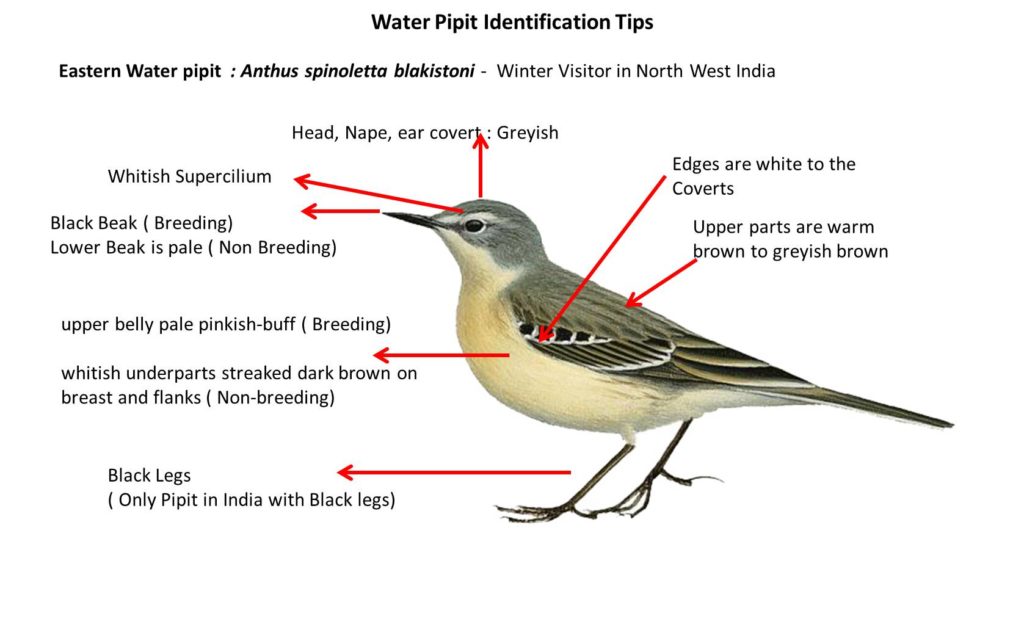Water Pipit

Water Pipit Anthus spinoletta
Etymology:
- Anthus : Based on Greek mythology. Anthus, son of Antinous and Hippodamia, was killed by his father’s horses and metamorphosed into a bird which imitated the neighing of horses but fled at their sight
- Spinoletta : Italian name for pipits
Distribution in India: Winter visitor in North India.
Description: Size of 15–17 cm; wt. of 18·7–23 g. The nominate race in breeding plumage has mid-grey to brownish-grey forehead, nape and ear-coverts and a contrasting broad whitish supercilium.The upperparts are greyish-brown;the mantle has faint dark streaks. The remiges and upperwing-coverts are blackish-brown with warm brown edges, median and greater coverts are with paler tips; tail is blackish-brown, T5 has small white tip; T6 has whitish outer web and distal part of inner web. The throat is whitish, dark malar streak usually faint; lower throat and breast to upper flanks and upper belly are pale pinkish-buff, occasionally slight dark streaking on breast, rest of underparts are whitish. The underwing-coverts and axillaries are white; iris and bill is blackish-brown; legs are dark brown or blackish-brown. In non-breeding plumage, grey on head is replaced by brown or grey-brown with thin darker streaks, supercilium is less distinct, narrow dark malar stripe and patch;warm brown upperparts indistinctly streaked dark, whitish on underparts and streaked dark brown on breast and flanks. The base of lower mandible is paler and yellowish. Both the sexes are similar, female on average more brownish, less grey, on head. The immature resembles non-breeding adult, but browner and with more obvious streaking above, darker streaking below. It breeds on alpine pastures and high-lying mountain meadows with short grassland and scattered rocks, bushes or trees, usually with some wet areas, often on mountain slopes; also stony scree with thickets .
Habitat: It is found in breeding season from 615–3200 m. In winter it is found on coastal saltings, lagoons, marshes, grassy edges of lakes and rivers, sewage farms, watercress farms, rice fields and other irrigated cultivation, often in association with Yellow Wagtail. It is found in winter from lowlands and to 2000 m.
Food habits: It eats Invertebrates like springtails, stoneflies, crickets and grasshoppers,bugs,lacewings and snake flies, scorpion flies, butterflies, moths and caterpillars, caddis flies , cicadas, aphids, psocids, flies, sawflies and ants, beetles, spiders, harvestmen, centipedes, millipedes, snails, amphipods and worms and also algae, berries and seeds .It forages on the ground, picking up insects and other small invertebrates; occasionally jumps up to take flying insects, or flies out from a perch to catch prey. In severe weather in high mountains, feeds around burrow entrances of marmots. During breeding season, foraging bouts are more frequent and flight distances greater when weather conditions poor. It forages singly or in pairs, sometimes in small groups.
Breeding habits: They breed in Apr to early Jul in Europe They are monogamous, occasionally polygynous or polyandrous. In song flight, male rises diagonally, flies in circle or arc, and descends in long looping glide. The nest is built mainly by female, sometimes helped by male. The nest is a cup of grass stems and leaves, some moss incorporated, lined with finer material and some hairs, placed on ground in side of a bank or hollow, usually well concealed by vegetation, sometimes at end of a tunnel. They lay a clutch of 4–6 eggs. The incubation is done by female only for a period of 14–15 days. The chicks are brooded by female and fed by male for first few days, thereafter fed by both parents. The nestling period is 14–15 days